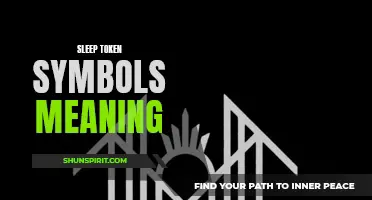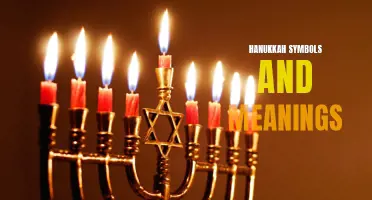
Ghanaian symbols are a rich representation of the country's cultural heritage and identity. These symbols, often portrayed through intricate artwork and carefully crafted designs, hold deep meanings and tell powerful stories. From the Adinkra symbols, which are traditionally used in fabric design and carry moral and philosophical messages, to indigenous symbols that depict sustainable farming practices and local customs, these symbols offer glimpses into Ghana's history, beliefs, and values. Exploring these symbols allows us to appreciate the beauty of Ghanaian artistry while also delving deeper into the intriguing tapestry of Ghanaian culture.
What You'll Learn
- What are some commonly recognized symbols in Ghanaian culture and what do they represent?
- How have Ghanaian symbols evolved over time Have their meanings changed?
- Are there any symbols unique to specific regions or tribes within Ghana?
- How are symbols used in Ghanaian art and design?
- Can you provide examples of how Ghanaian symbols have been incorporated into everyday life, such as clothing or architecture?

What are some commonly recognized symbols in Ghanaian culture and what do they represent?
Ghanaian culture is rich in symbolism, with various symbols representing different aspects of their history, traditions, and beliefs. These symbols have been passed down through generations and are still widely recognized and celebrated in Ghana today. Here are some commonly recognized symbols in Ghanaian culture and what they represent:
Adinkra Symbols: Adinkra symbols are visual representations of concepts and proverbs used by the Akan people of Ghana. These symbols are traditionally printed on cloth and used for important occasions such as funerals, weddings, and festivals. Each symbol carries its own meaning and message. For example, the Sankofa symbol represents the importance of learning from the past, while the Gye Nyame symbol represents the supremacy of God.
Kente Cloth: Kente cloth is a brightly colored fabric that is intricately woven by the Ashanti people of Ghana. The colors and patterns of the cloth hold symbolic meaning. For example, black represents spirituality and maturity, while yellow represents royalty and wealth. Different patterns and designs also have specific meanings. Kente cloth is often worn on special occasions to represent cultural heritage and identity.
Adrinka Stools: Stools hold great cultural significance in Ghanaian society. They are used in various ceremonies and rituals and are often seen as symbols of authority and leadership. Adinkra symbols are sometimes carved into stools, further adding to their symbolic value. Each stool represents a different clan or family, and the symbols on the stool represent the family's values and history.
Drumming and Dance: Drumming and dance are integral parts of Ghanaian culture and carry deep symbolic meaning. Different drummers and dances are associated with specific occasions, such as funerals or festivals. The rhythms and movements of the drums and dances convey messages and emotions, allowing the community to come together and express themselves.
Akan Names: Akan names in Ghana often have symbolic meanings. These names are carefully chosen to reflect the circumstances surrounding a child's birth or the family's beliefs and values. For example, the name Kwame is given to a child born on a Saturday, while the name Abena is given to a child born on Tuesday. The names not only carry personal significance but also represent a connection to the larger Ghanaian cultural identity.
Colors: Colors also hold symbolic meaning in Ghanaian culture. For example, red represents bloodshed and sacrifice, while green represents fertility and growth. These colors are often used in clothing and decorations during celebrations and ceremonies to convey specific messages and evoke specific emotions.
Overall, symbols play a crucial role in Ghanaian culture, representing various aspects of their history, traditions, and beliefs. Whether it be through Adinkra symbols, Kente cloth, stools, drumming and dance, Akan names, or colors, these symbols are deeply ingrained in Ghanaian society and serve to connect individuals to their cultural heritage.
Exploring the Symbolic Meaning Behind Pigeons: What Do They Represent?
You may want to see also

How have Ghanaian symbols evolved over time? Have their meanings changed?
Symbols play a significant role in every culture, representing important ideas, values, and beliefs. In Ghanaian culture, symbols hold deep cultural and historical significance. Over time, these symbols have evolved and undergone changes, reflecting the shifting dynamics of society. In this article, we will explore the evolution of Ghanaian symbols and their changing meanings.
Ghanaian symbols, also known as adinkra symbols, originated from the Ashanti kingdom in present-day Ghana. These symbols were traditionally used on cloth, pottery, and other artistic mediums. Each symbol carries a unique meaning, often conveying proverbs, historical events, or moral values.
One example of a Ghanaian symbol is the Sankofa bird. This symbol depicts a bird with its head turned backward, picking up an egg from its back. Sankofa represents the importance of learning from the past in order to move forward. In traditional Ghanaian society, this symbol emphasized the value of wisdom and the need to respect elders.
However, as Ghanaian society has evolved, so has the meaning of the Sankofa symbol. In contemporary times, the Sankofa bird is widely embraced as a symbol of African diaspora and the reclamation of African heritage. It has become a rallying cry for African Americans and those of African descent to reconnect with their roots and embrace their cultural heritage.
Another significant Ghanaian symbol is the Adinkra symbol, Gye Nyame, which means "except God." This symbol represents the supremacy of God and the belief that all power comes from a higher being. Traditionally, this symbol was used to convey the importance of acknowledging and revering the divine.
In recent years, the Gye Nyame symbol has taken on a wider meaning. It has become a symbol of pride and resilience among Ghanaians, encapsulating the idea that with God, all things are possible. This symbol has come to represent the faith and strength of the Ghanaian people, particularly during times of adversity.
The meanings of other Ghanaian symbols have also evolved over time. Symbols such as the Adinkrahene, which represents greatness and leadership, and the Akoben, which symbolizes vigilance and war, have retained their original meanings but have also been adopted as symbols of Ghanaian identity and pride.
In conclusion, Ghanaian symbols have undergone significant changes in meaning over time. While their original interpretations still hold relevance in traditional contexts, these symbols have also come to represent larger ideas and values in contemporary Ghanaian society. The evolution of these symbols reflects the changing dynamics of Ghanaian culture and the desire to embrace and celebrate Ghanaian heritage in a modern world.
Exploring the Hidden Symbolism and Rich Meanings of Chumash Symbols
You may want to see also

Are there any symbols unique to specific regions or tribes within Ghana?
Ghana, located in West Africa, is a culturally diverse country with numerous tribes and ethnic groups. Each tribe within Ghana has its unique symbols and traditions, which contribute to the richness and diversity of Ghanaian culture. These symbols often carry deep spiritual and historical significance for their respective tribes.
One of the most well-known tribes in Ghana is the Ashanti tribe, which is known for its vibrant art and history. The Ashanti tribe uses various symbols in their traditional practices and art forms. One famous symbol is the Adinkra symbols, which are popularly used in textiles, ceramics, and architecture. These symbols are believed to have originated from the Ashanti kingdom in the 19th century and were used to communicate messages and convey meanings. The Adinkra symbols often represent proverbs, wisdom, and moral values. Some well-known Adinkra symbols include the Sankofa, which represents the importance of learning from the past, and the Gye Nyame, which symbolizes the supremacy of God.
Another tribe in Ghana that has unique symbols is the Akan tribe. The Akan people have a rich cultural heritage, and their symbols are widely used in their arts and crafts. One famous symbol is the Ananse Ntontan, which represents wisdom, creativity, and the power of storytelling. The symbol depicts a spider, known as Ananse in Akan mythology, and exemplifies the importance of wisdom and ingenuity in Akan culture. Another significant Akan symbol is the Nkyinkyim, which symbolizes versatility and dynamic movement. It is often associated with adaptability and the ability to navigate through life's challenges.
The Ga tribe, another prominent tribe in Ghana, also has its unique symbols. The Ga people have a rich history of fishing and are known for their fishing-related symbols. One famous symbol is the Dipo Kpona, which represents femininity and the transition from girlhood to womanhood. This symbol is often used during the Dipo initiation ceremony, where young girls are initiated into womanhood. It is a symbol of beauty, strength, and fertility. Another important symbol of the Ga people is the Nkatia, a deity symbolizing protectiveness and strength. The Nkatia symbol is often worn as a pendant or printed on cloth as a sign of protection and spiritual guidance.
These are just a few examples of the many symbols unique to specific regions or tribes within Ghana. Each tribe has its distinctive symbols, which vary in meaning and cultural significance. These symbols play a crucial role in preserving and celebrating Ghanaian culture and heritage. They are often passed down from generation to generation and continue to be an essential part of Ghanaian identity. The symbols serve as a visual language, communicating shared values, beliefs, and history within their respective tribes and communities. They also contribute to the overall tapestry of Ghanaian culture, representing the diverse heritage and traditions of the country.
Decoding the Language of Gang Graffiti: Unraveling the Symbols and Meanings
You may want to see also

How are symbols used in Ghanaian art and design?
Symbols play a significant role in Ghanaian art and design, as they convey deeper meanings and cultural values. These symbols can be found in various forms of artistic expressions, such as textiles, wood carvings, pottery, and even architecture. Each symbol carries its own unique significance and is often used to tell stories, express emotions, or communicate ideas.
One of the most widely used symbols in Ghanaian art is Adinkra. Adinkra symbols are visual representations of Akan proverbs and philosophical concepts. They originated from the Ashanti people of Ghana and were traditionally printed on cloth using adinkra stamps made from carved calabashes. Adinkra symbols can be seen on traditional Ashanti clothing, as well as on pottery and in other forms of artistic expression. Each symbol has a specific meaning, such as the Sankofa symbol which represents the importance of learning from the past, or the Akofena symbol which symbolizes courage and valor.
Another important symbol in Ghanaian art is the Gye Nyame symbol. This symbol, which means "except for God," is often used to represent the belief in the omnipotence of God in Ghanaian culture. It is often seen on clothing, jewelry, and even incorporated into home decor. The Gye Nyame symbol serves as a constant reminder of the divine presence in the lives of Ghanaians and their reliance on God.
In addition to these traditional symbols, modern Ghanaian artists also incorporate contemporary symbols into their work. These symbols may include references to popular culture, current events, or even political ideologies. For example, some artists use the image of the Black Star, which is the symbol of Ghana's independence, to represent national pride and identity. Others may use symbols related to Pan-Africanism, such as the image of a clenched fist, to express solidarity with the African diaspora and a commitment to liberation.
Symbols in Ghanaian art not only convey deeper meanings but also serve as a way to preserve and pass on cultural traditions. Traditional symbols are often taught and passed down through generations, ensuring that the values and beliefs they represent are carried forward. In this way, symbols in Ghanaian art play a crucial role in the preservation and celebration of Ghanaian culture.
Overall, symbols are an essential part of Ghanaian art and design, adding depth and meaning to artistic expressions. They can be found in various forms of artistic media and convey a range of emotions, ideas, and cultural values. Whether traditional or contemporary, symbols in Ghanaian art serve as a way to communicate and express the rich cultural heritage of Ghana.
Decoding the Symbols on Your Omron Blood Pressure Monitor: What Do They Mean?
You may want to see also

Can you provide examples of how Ghanaian symbols have been incorporated into everyday life, such as clothing or architecture?
Ghanaian symbols have a rich cultural significance and hold deep meaning for the people of Ghana. These symbols have been incorporated into various aspects of everyday life, such as clothing, architecture, and even everyday objects. Let's explore some examples of how these symbols have been integrated into Ghanaian culture.
One popular way in which Ghanaian symbols are incorporated into everyday life is through clothing. Traditional Ghanaian clothing, such as the Kente cloth, often features these symbols intricately woven into the fabric. The Kente cloth is a vibrant and colorful fabric that is handwoven by Ghanaian artisans. Each symbol used in the cloth has its own meaning and tells a unique story. By wearing clothing adorned with these symbols, Ghanaians proudly showcase their cultural heritage and identity.
Ghanaian symbols can also be found in architecture throughout the country. Many buildings in Ghana, both traditional and modern, incorporate these symbols as decorative elements. For instance, the National Theatre in Accra, the capital city of Ghana, features intricate carvings of Adinkra symbols on its exterior. These symbols not only add beauty to the structure but also serve as a reminder of Ghanaian culture and values.
In addition to clothing and architecture, Ghanaian symbols can be seen in everyday objects used by Ghanaians. For example, traditional pottery often features these symbols as decorative elements. The symbols may be carved or painted onto the pottery, adding a touch of cultural significance to the everyday items used by Ghanaians.
Furthermore, Ghanaian symbols are also incorporated into jewelry designs. Many Ghanaians wear jewelry adorned with these symbols, such as necklaces, bracelets, and earrings. These pieces of jewelry not only serve as fashionable accessories but also hold personal and cultural significance for the wearer.
Ghanaian symbols are not limited to physical objects but also have a presence in the digital space. In recent years, there has been an emergence of graphic designers and artists incorporating these symbols into digital artwork and designs. These designs can be found on websites, social media platforms, and even in digital advertisements. They not only showcase the rich cultural heritage of Ghana but also serve as a way of keeping the symbols alive in the digital age.
In conclusion, Ghanaian symbols have been successfully integrated into various aspects of everyday life in Ghana. From clothing to architecture, and from pottery to digital designs, these symbols play a significant role in showcasing Ghanaian culture and values. Whether it be through traditional clothing, decorative architecture, or everyday objects, these symbols serve as a reminder of Ghanaian heritage and identity.
The Mystical Meanings Behind Bat Symbolism
You may want to see also
Frequently asked questions
Answer 1: The Sankofa symbol in Ghanaian culture represents the importance of learning from the past. It is often depicted as a bird with its head turned backward, symbolizing the idea of looking back at the past for guidance and wisdom in moving forward.
Question 2: What does the Akoben symbol stand for?
Answer 2: The Akoben symbol is a representation of a war horn and symbolizes vigilance and wariness. It is often used to remind individuals to be alert and ready to defend their community or values.
Question 3: What is the significance of the Gye Nyame symbol?
Answer 3: The Gye Nyame symbol is one of the most widely recognized Adinkra symbols and represents the omnipotence and supremacy of God. It translates to "Except for God" and signifies the belief that God is the ultimate protector and provider.
Question 4: What is the meaning of the Funtumfunafu-Denkyemfunefu symbol?
Answer 4: The Funtumfunafu-Denkyemfunefu symbol represents unity, diversity, and interdependence. It consists of two crocodiles sharing one stomach, symbolizing the importance of working together and valuing diversity in order to achieve success.







